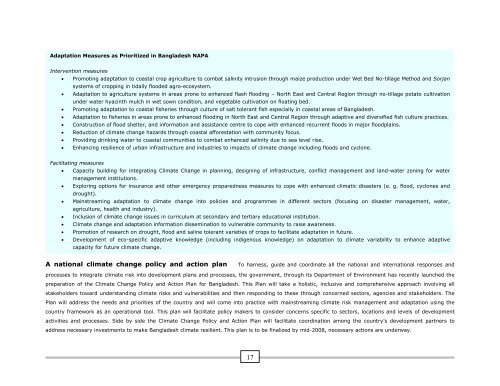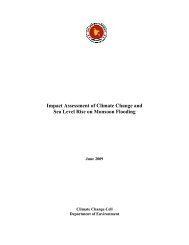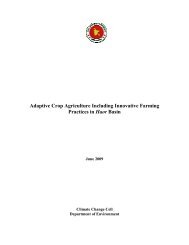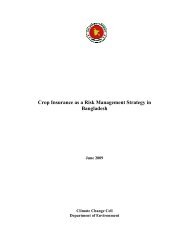CLIMATE CHANGE AND BANGLADESH
CLIMATE CHANGE AND BANGLADESH
CLIMATE CHANGE AND BANGLADESH
You also want an ePaper? Increase the reach of your titles
YUMPU automatically turns print PDFs into web optimized ePapers that Google loves.
Adaptation Measures as Prioritized in Bangladesh NAPA<br />
Intervention measures<br />
• Promoting adaptation to coastal crop agriculture to combat salinity intrusion through maize production under Wet Bed No-tillage Method and Sorjan<br />
systems of cropping in tidally flooded agro-ecosystem.<br />
• Adaptation to agriculture systems in areas prone to enhanced flash flooding – North East and Central Region through no-tillage potato cultivation<br />
under water hyacinth mulch in wet sown condition, and vegetable cultivation on floating bed.<br />
• Promoting adaptation to coastal fisheries through culture of salt tolerant fish especially in coastal areas of Bangladesh.<br />
• Adaptation to fisheries in areas prone to enhanced flooding in North East and Central Region through adaptive and diversified fish culture practices.<br />
• Construction of flood shelter, and information and assistance centre to cope with enhanced recurrent floods in major floodplains.<br />
• Reduction of climate change hazards through coastal afforestation with community focus.<br />
• Providing drinking water to coastal communities to combat enhanced salinity due to sea level rise.<br />
• Enhancing resilience of urban infrastructure and industries to impacts of climate change including floods and cyclone.<br />
Facilitating measures<br />
• Capacity building for integrating Climate Change in planning, designing of infrastructure, conflict management and land-water zoning for water<br />
management institutions.<br />
• Exploring options for insurance and other emergency preparedness measures to cope with enhanced climatic disasters (e. g. flood, cyclones and<br />
drought).<br />
• Mainstreaming adaptation to climate change into policies and programmes in different sectors (focusing on disaster management, water,<br />
agriculture, health and industry).<br />
• Inclusion of climate change issues in curriculum at secondary and tertiary educational institution.<br />
• Climate change and adaptation information dissemination to vulnerable community to raise awareness.<br />
• Promotion of research on drought, flood and saline tolerant varieties of crops to facilitate adaptation in future.<br />
• Development of eco-specific adaptive knowledge (including indigenous knowledge) on adaptation to climate variability to enhance adaptive<br />
capacity for future climate change.<br />
A national climate change policy and action plan To harness, guide and coordinate all the national and international responses and<br />
processes to integrate climate risk into development plans and processes, the government, through its Department of Environment has recently launched the<br />
preparation of the Climate Change Policy and Action Plan for Bangladesh. This Plan will take a holistic, inclusive and comprehensive approach involving all<br />
stakeholders toward understanding climate risks and vulnerabilities and then responding to these through concerned sectors, agencies and stakeholders. The<br />
Plan will address the needs and priorities of the country and will come into practice with mainstreaming climate risk management and adaptation using the<br />
country framework as an operational tool. This plan will facilitate policy makers to consider concerns specific to sectors, locations and levels of development<br />
activities and processes. Side by side the Climate Change Policy and Action Plan will facilitate coordination among the country’s development partners to<br />
address necessary investments to make Bangladesh climate resilient. This plan is to be finalized by mid-2008, necessary actions are underway.<br />
17





